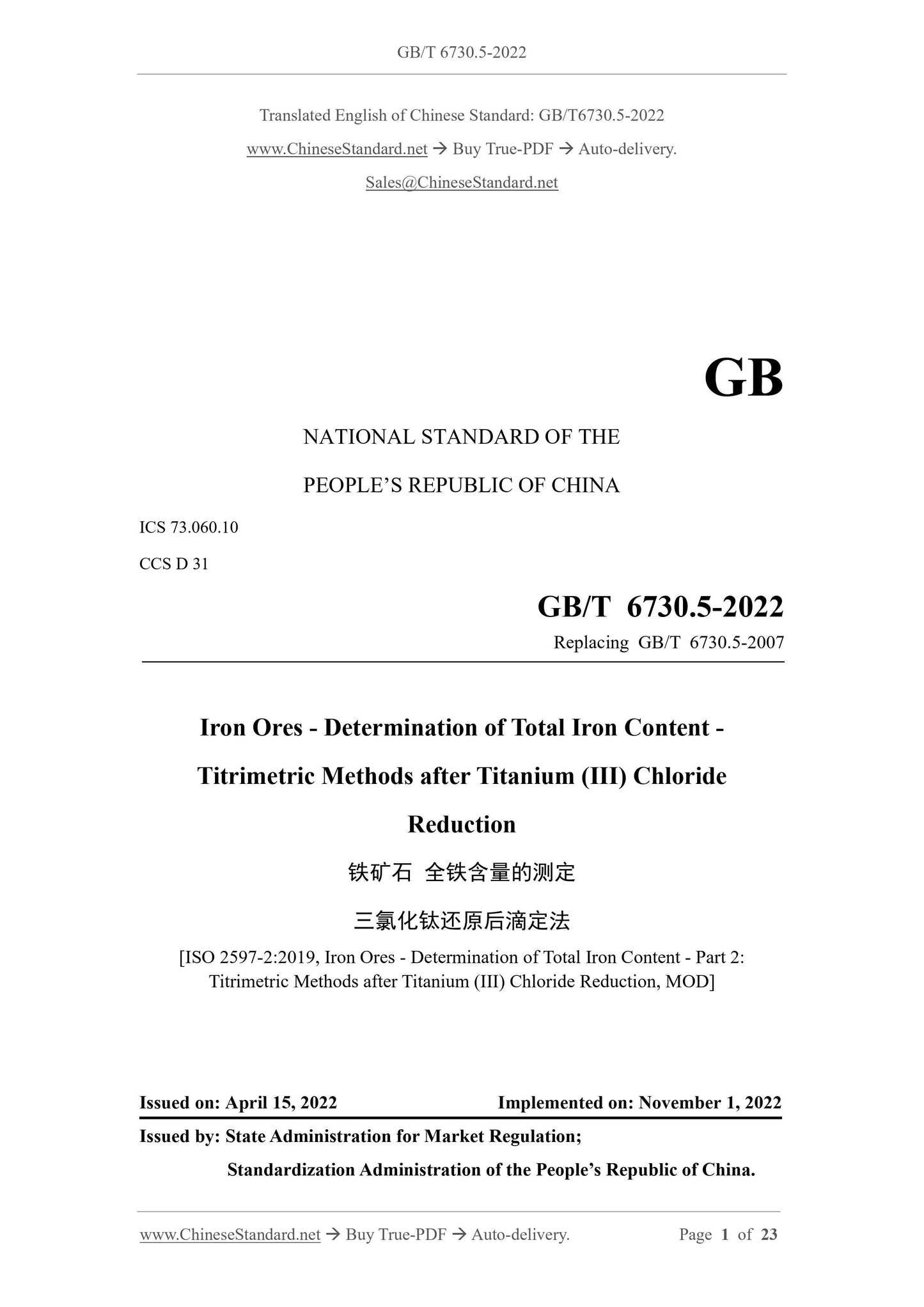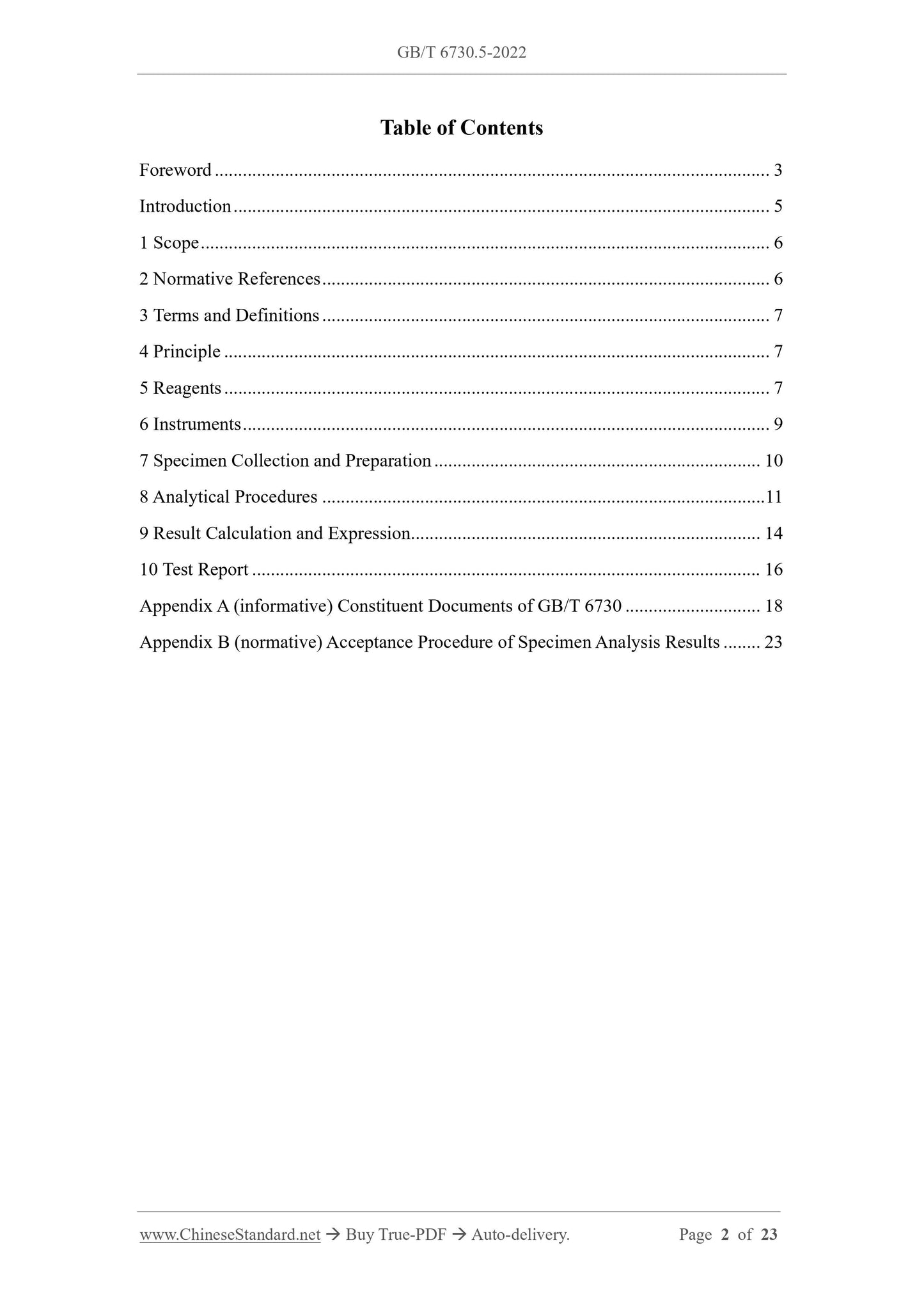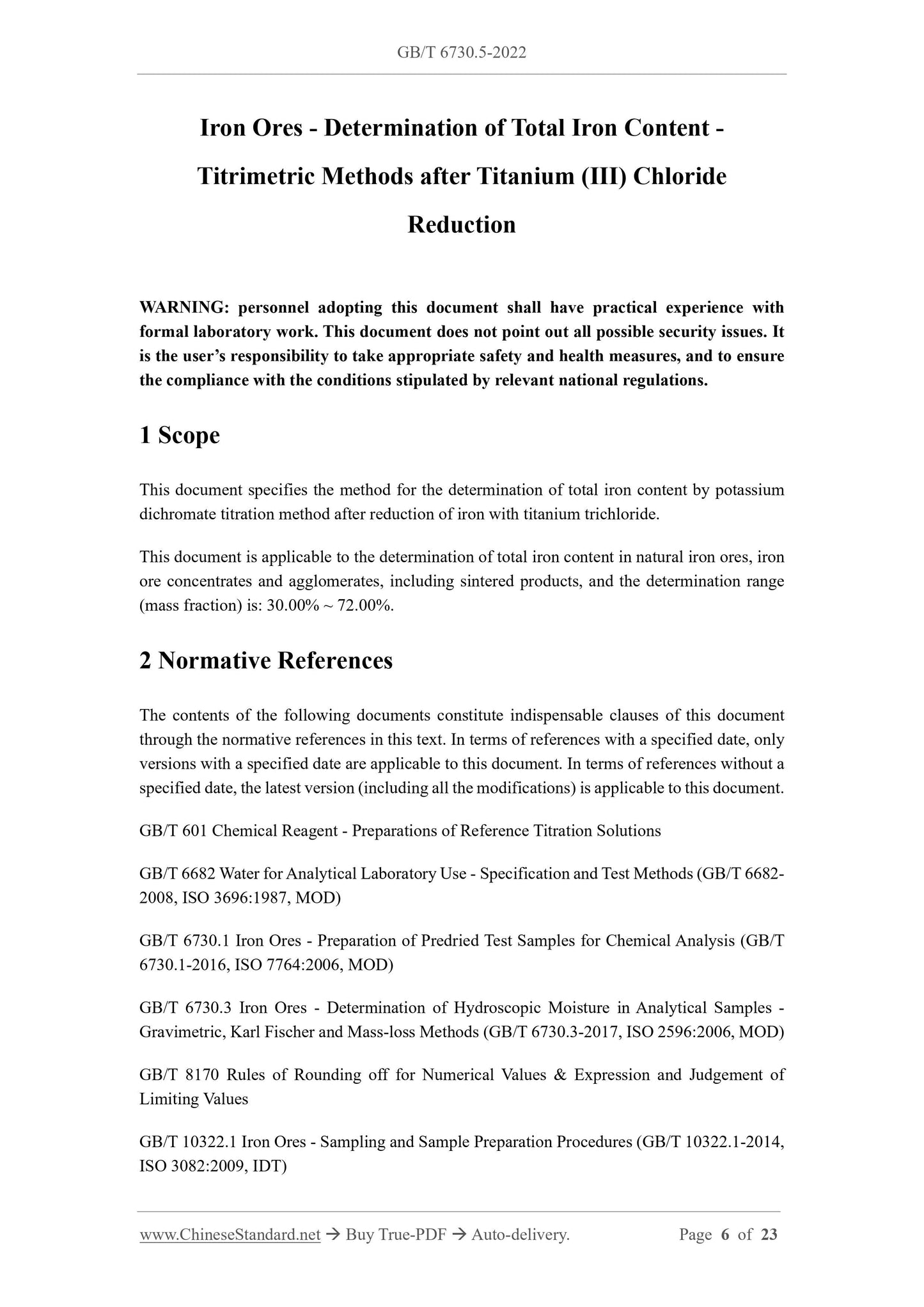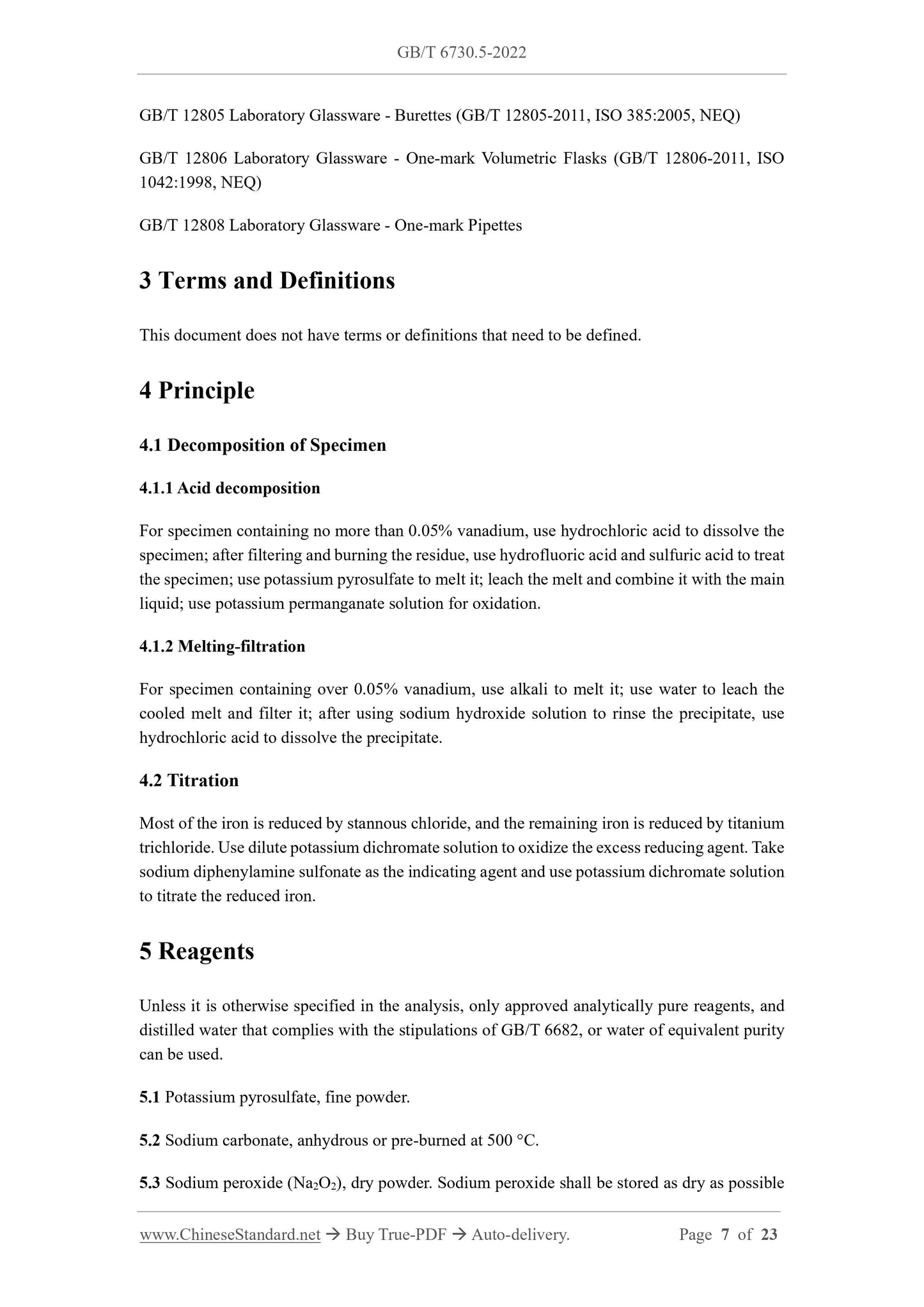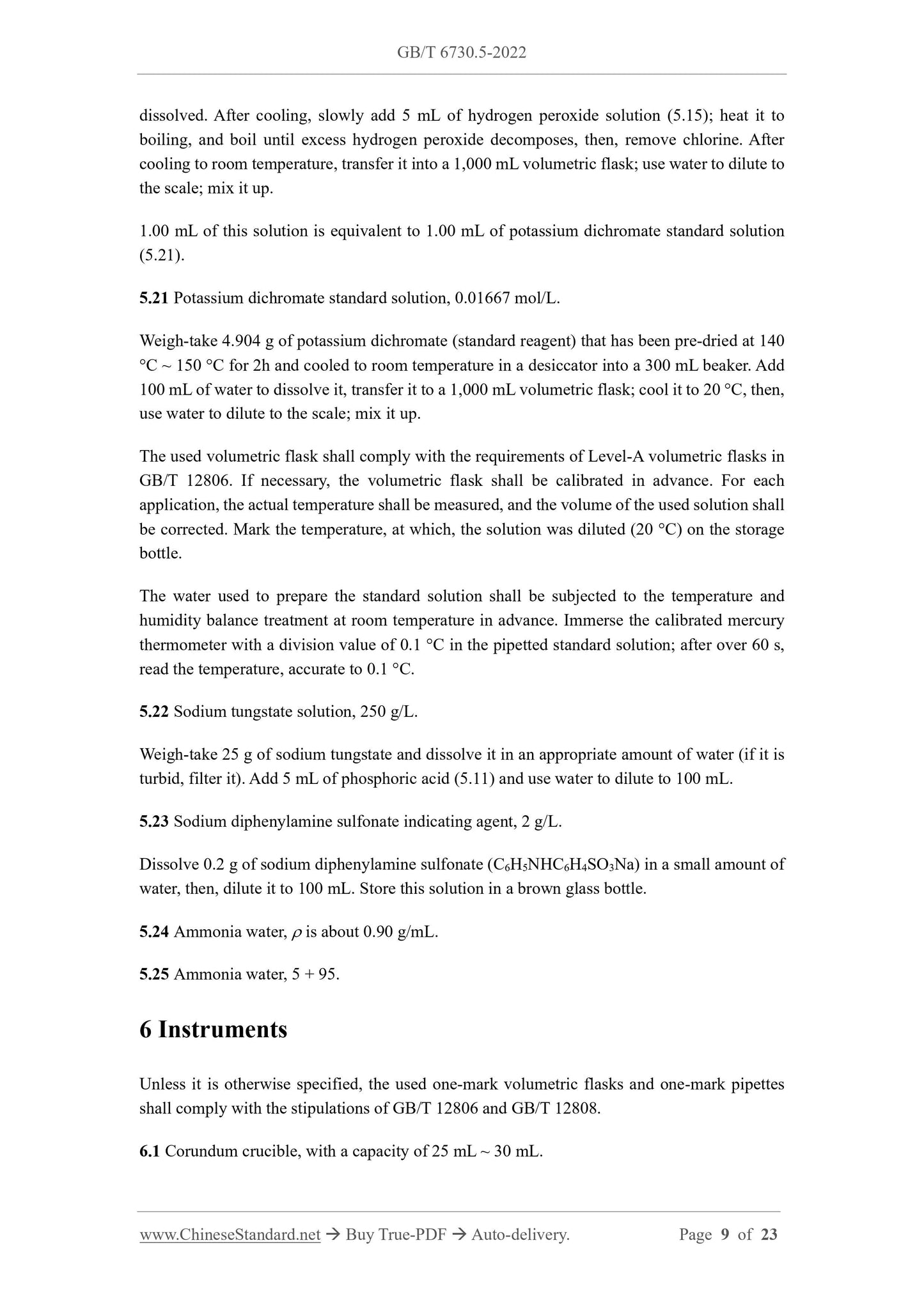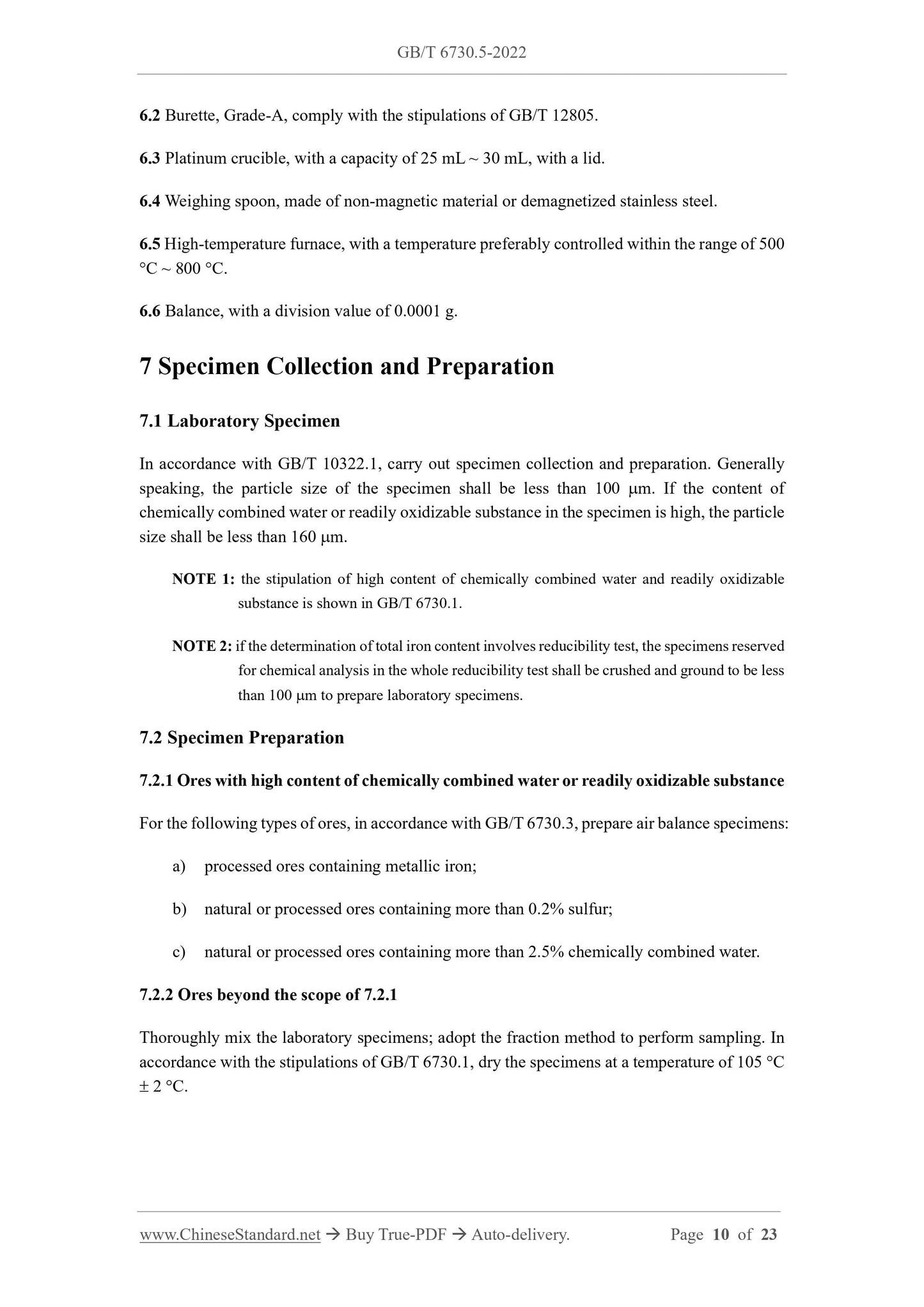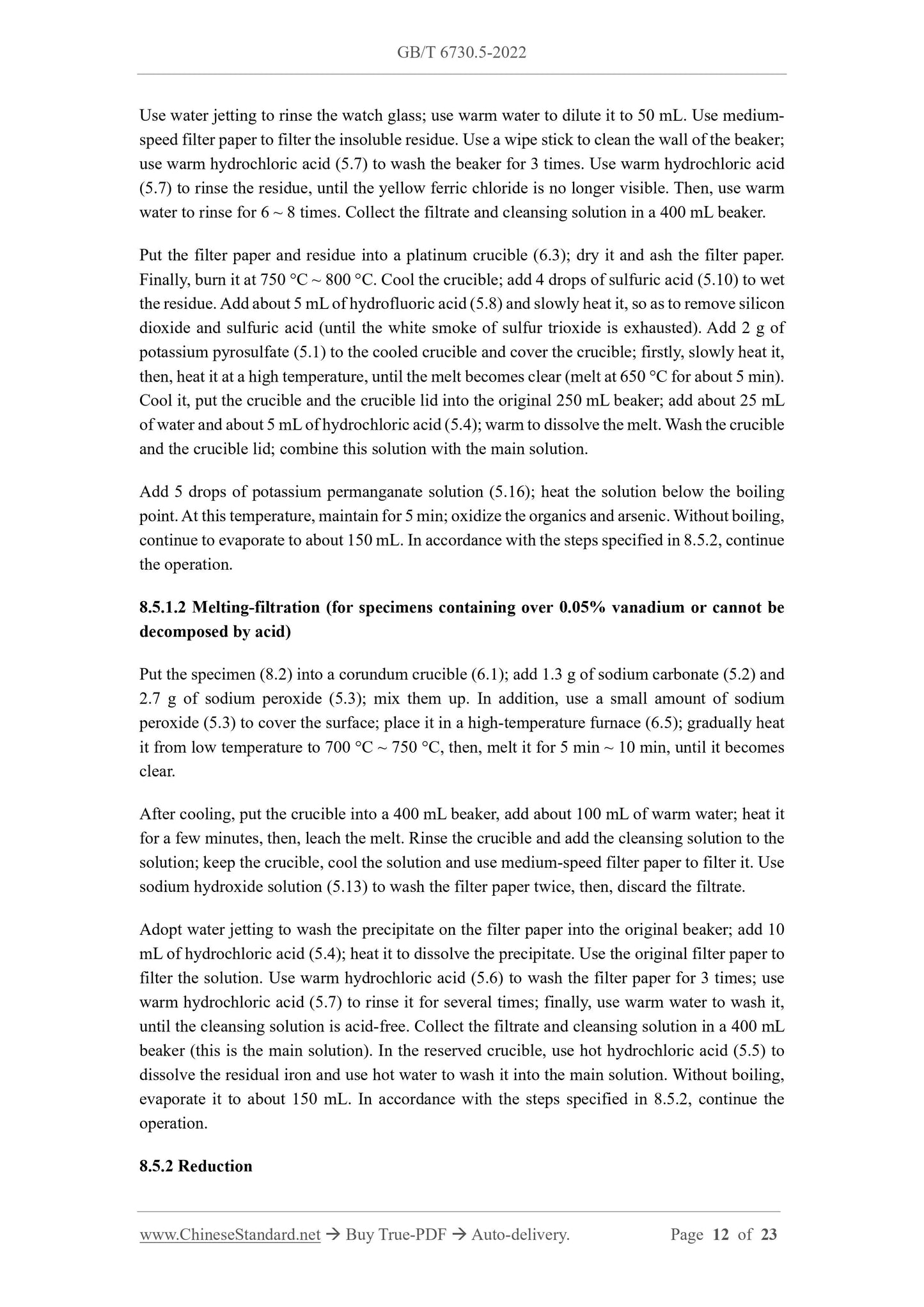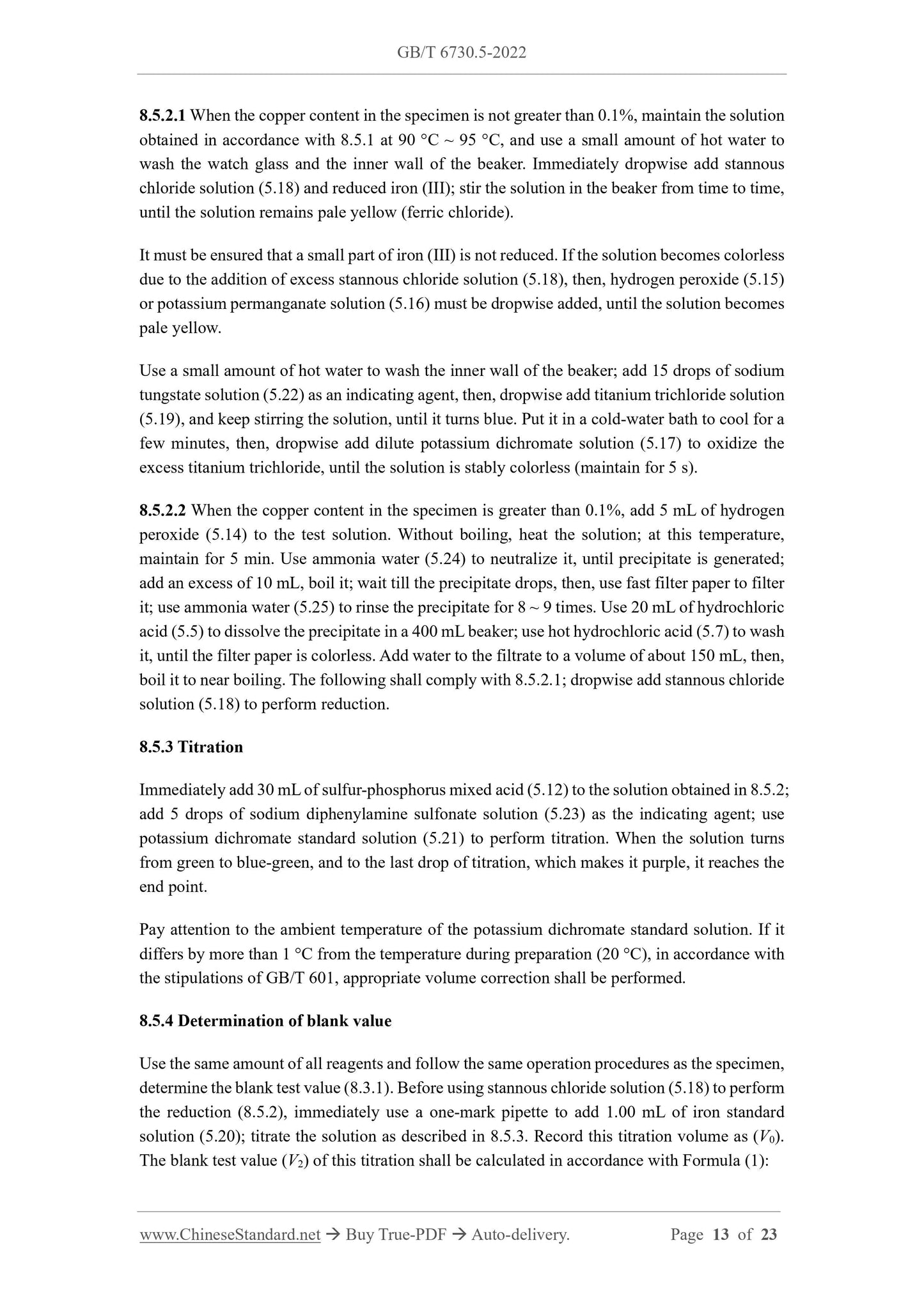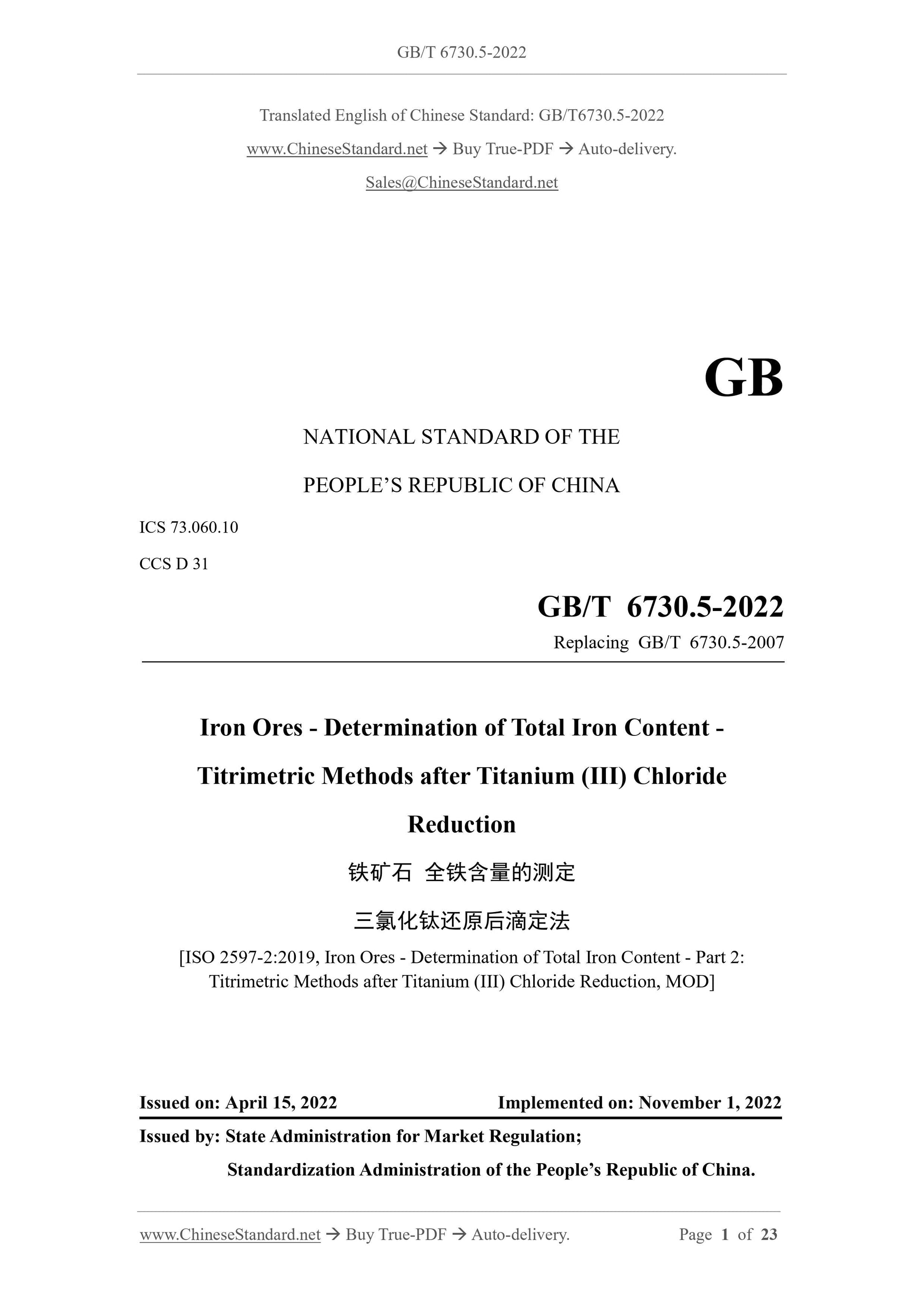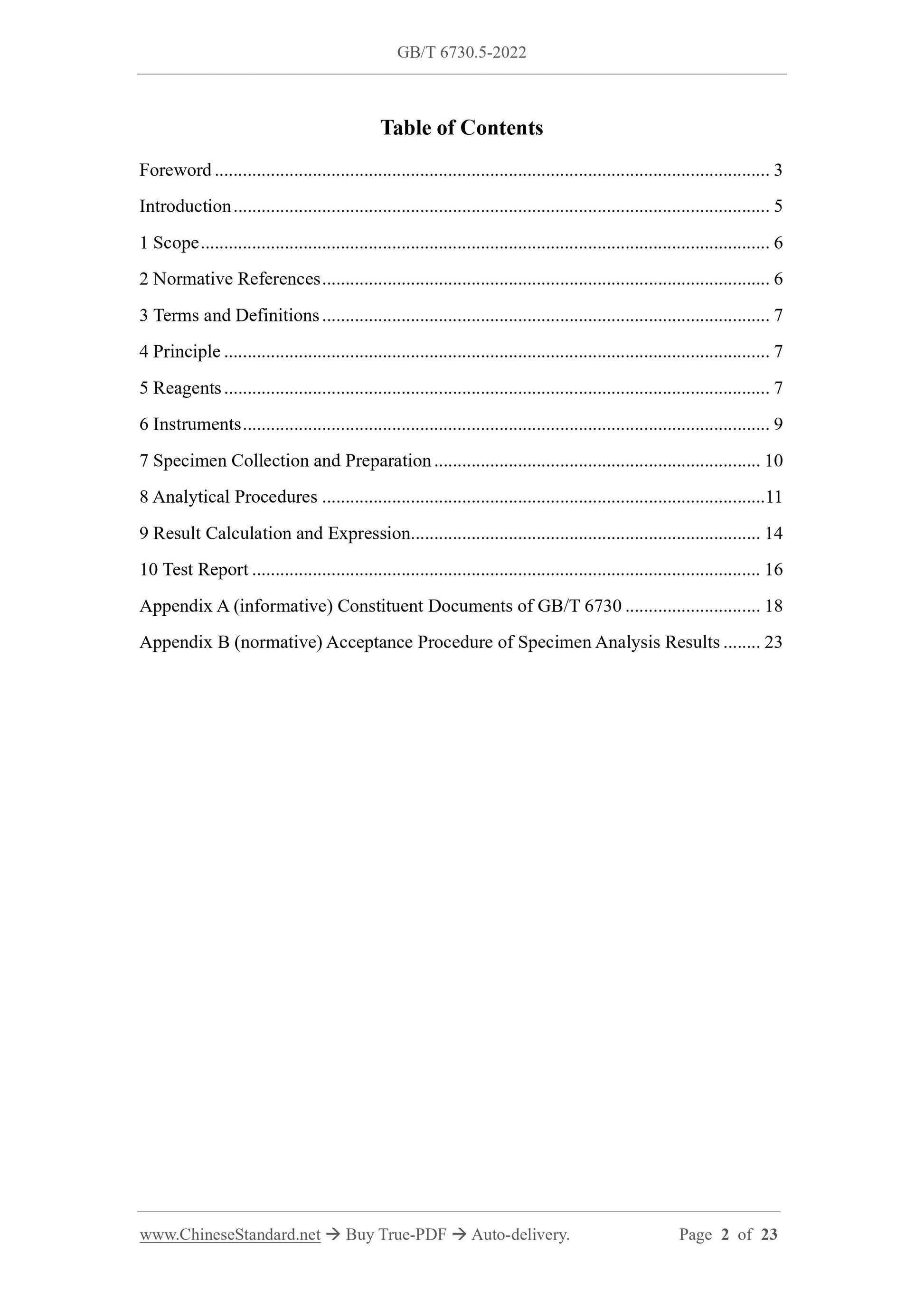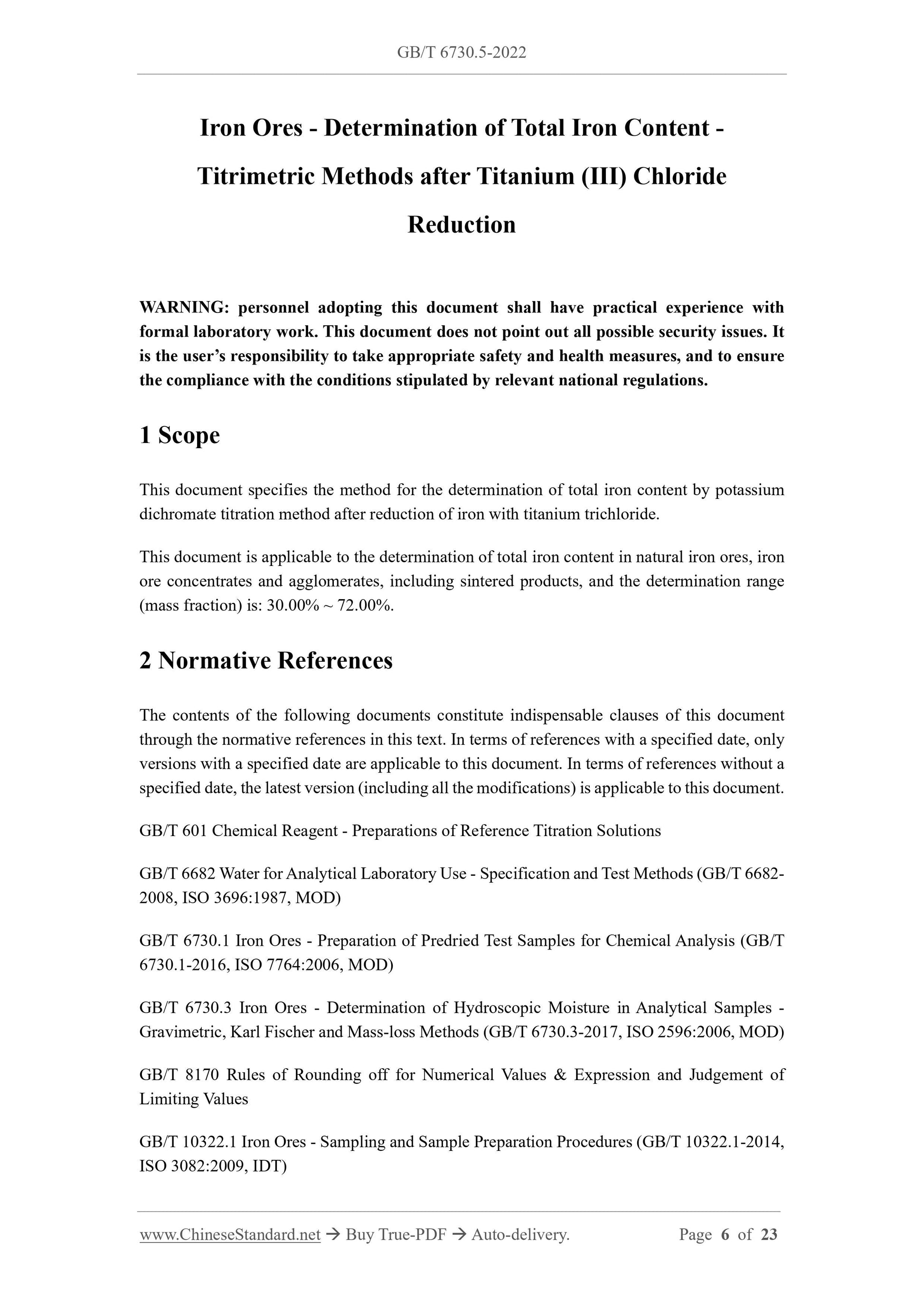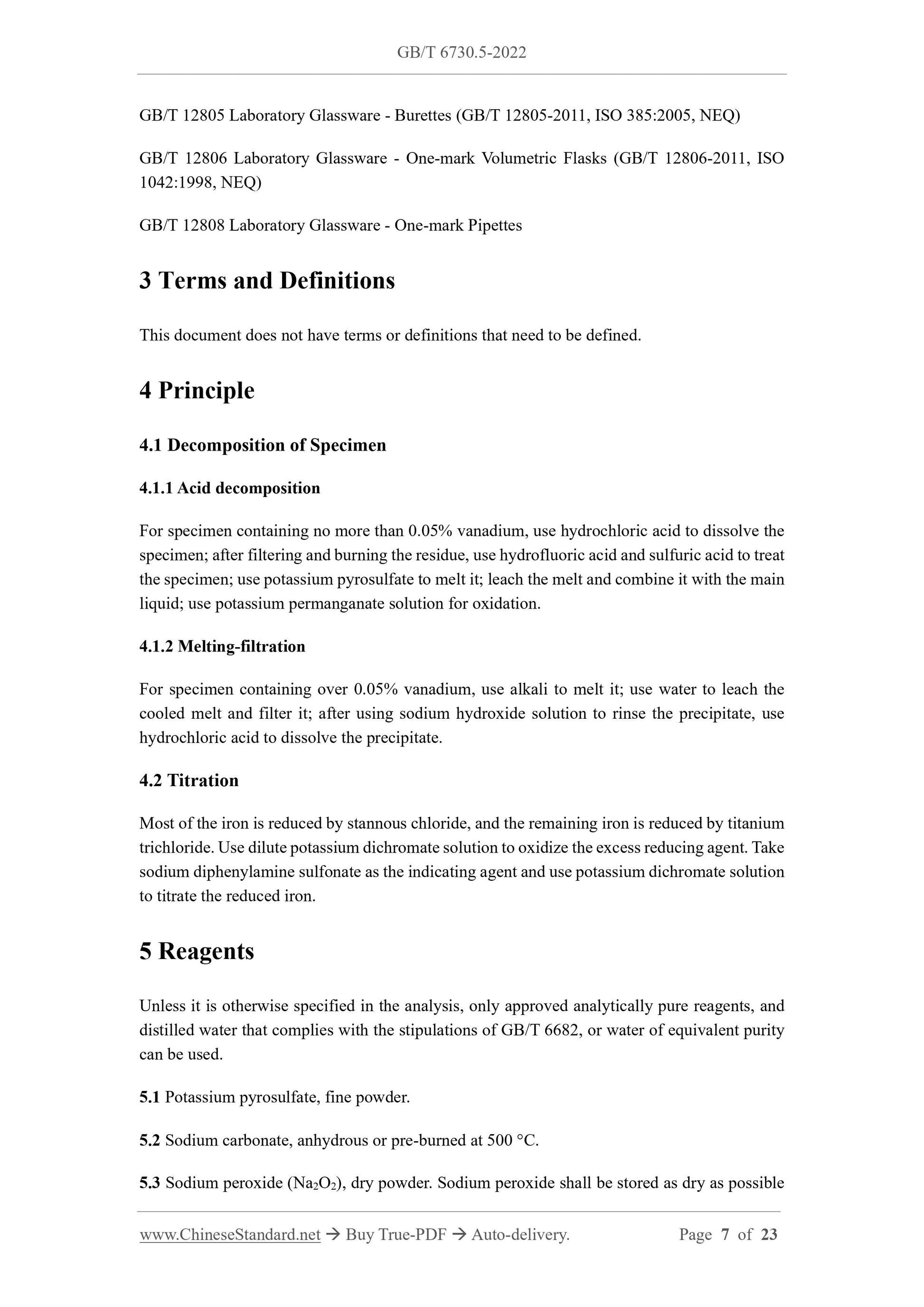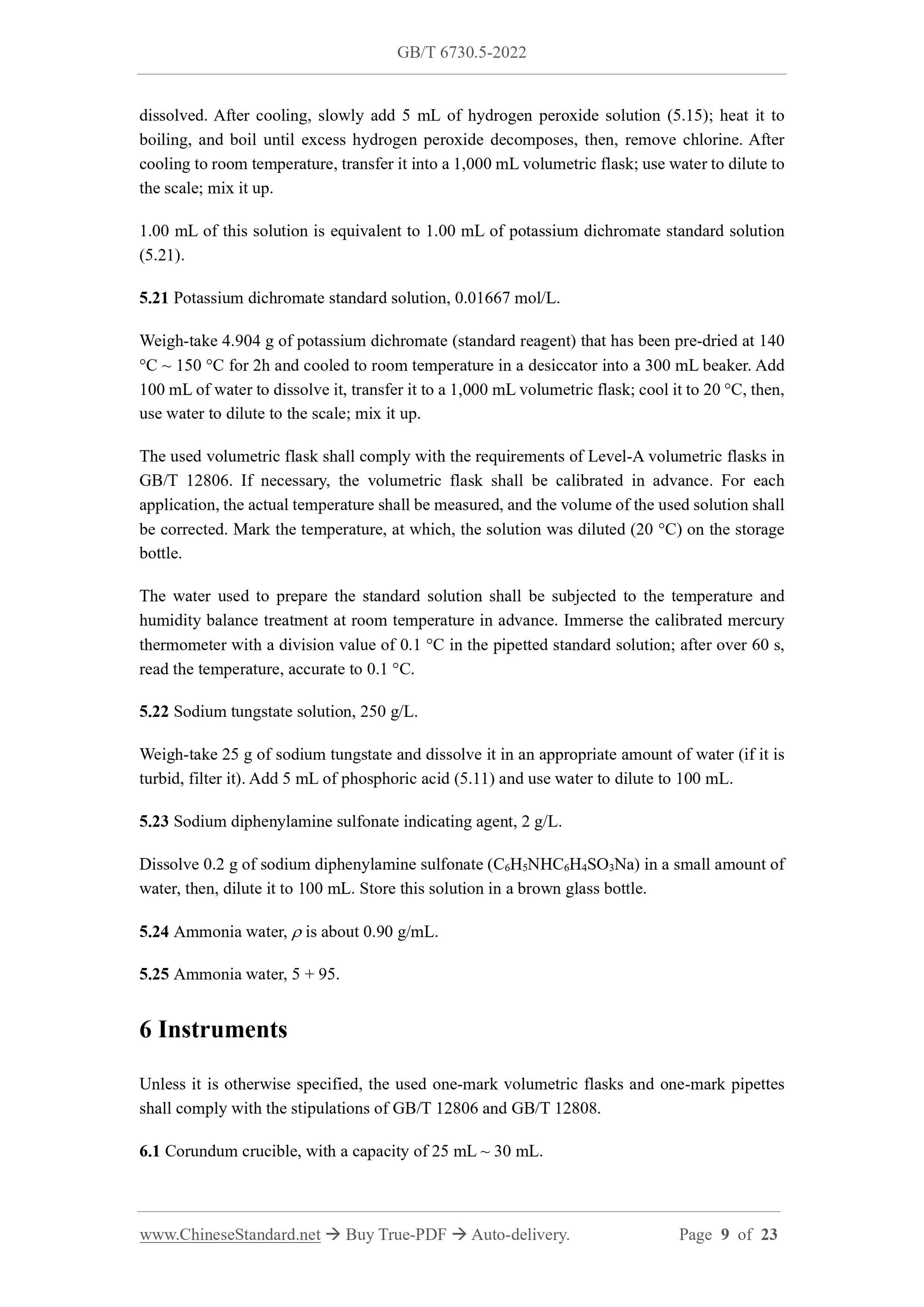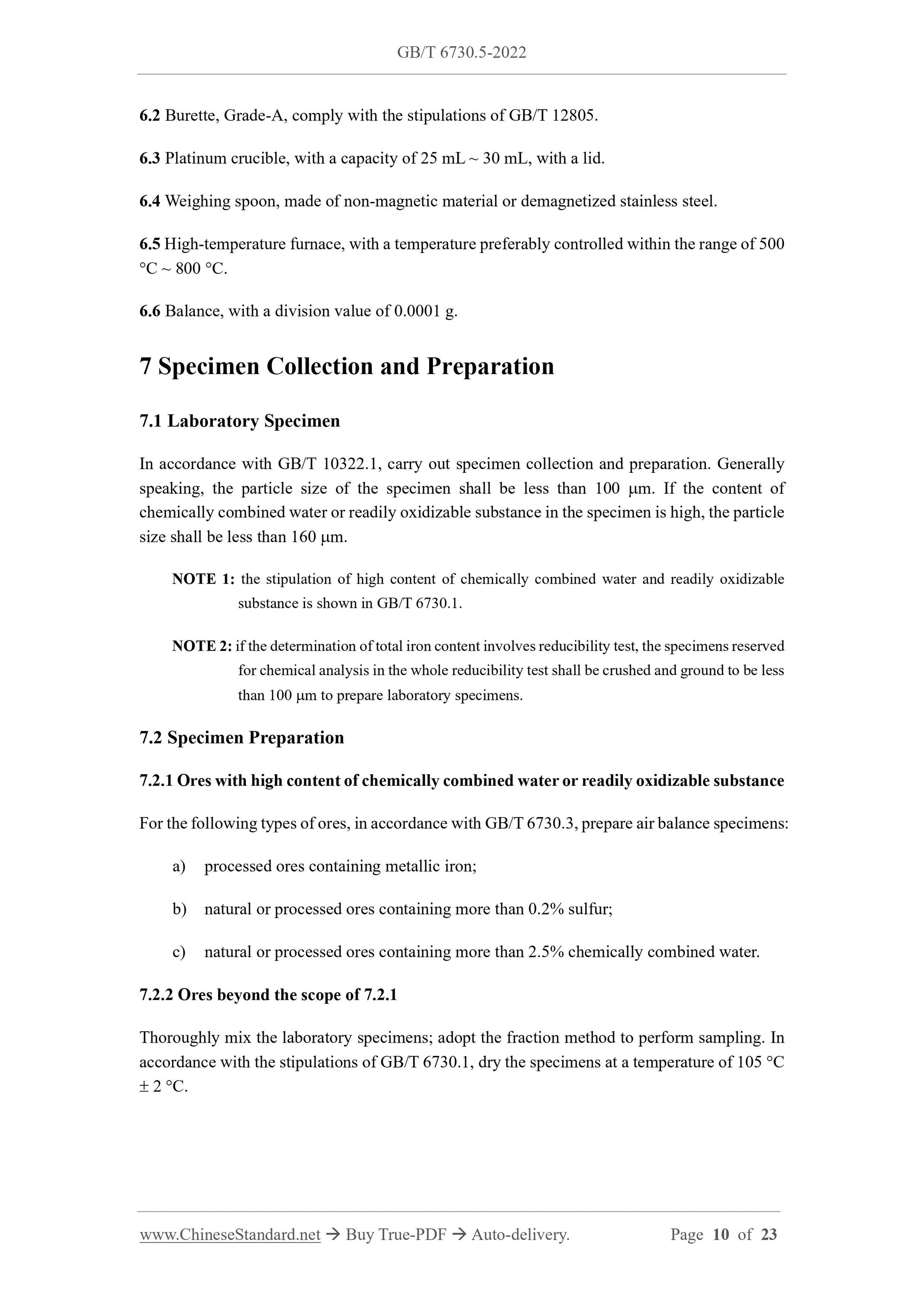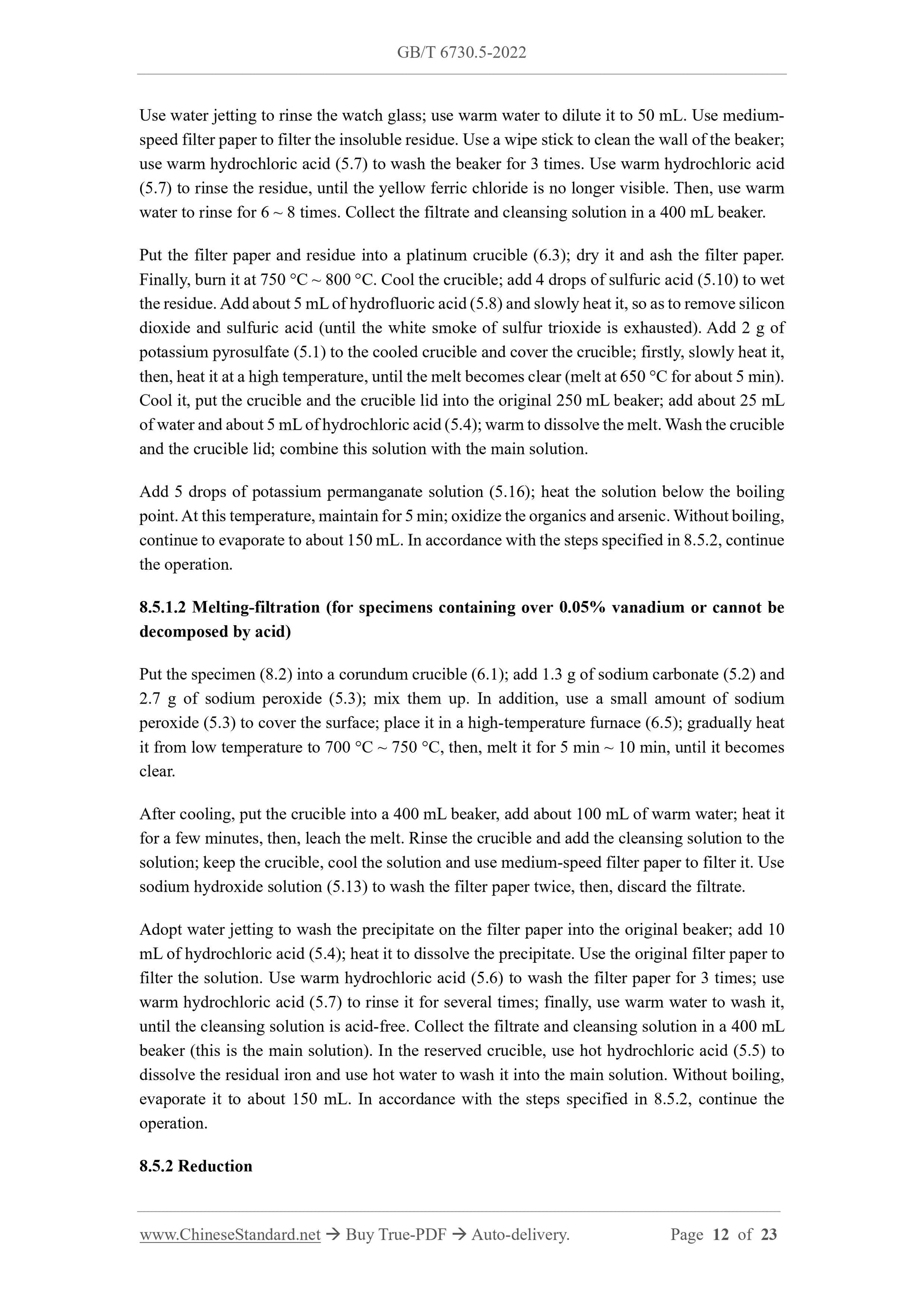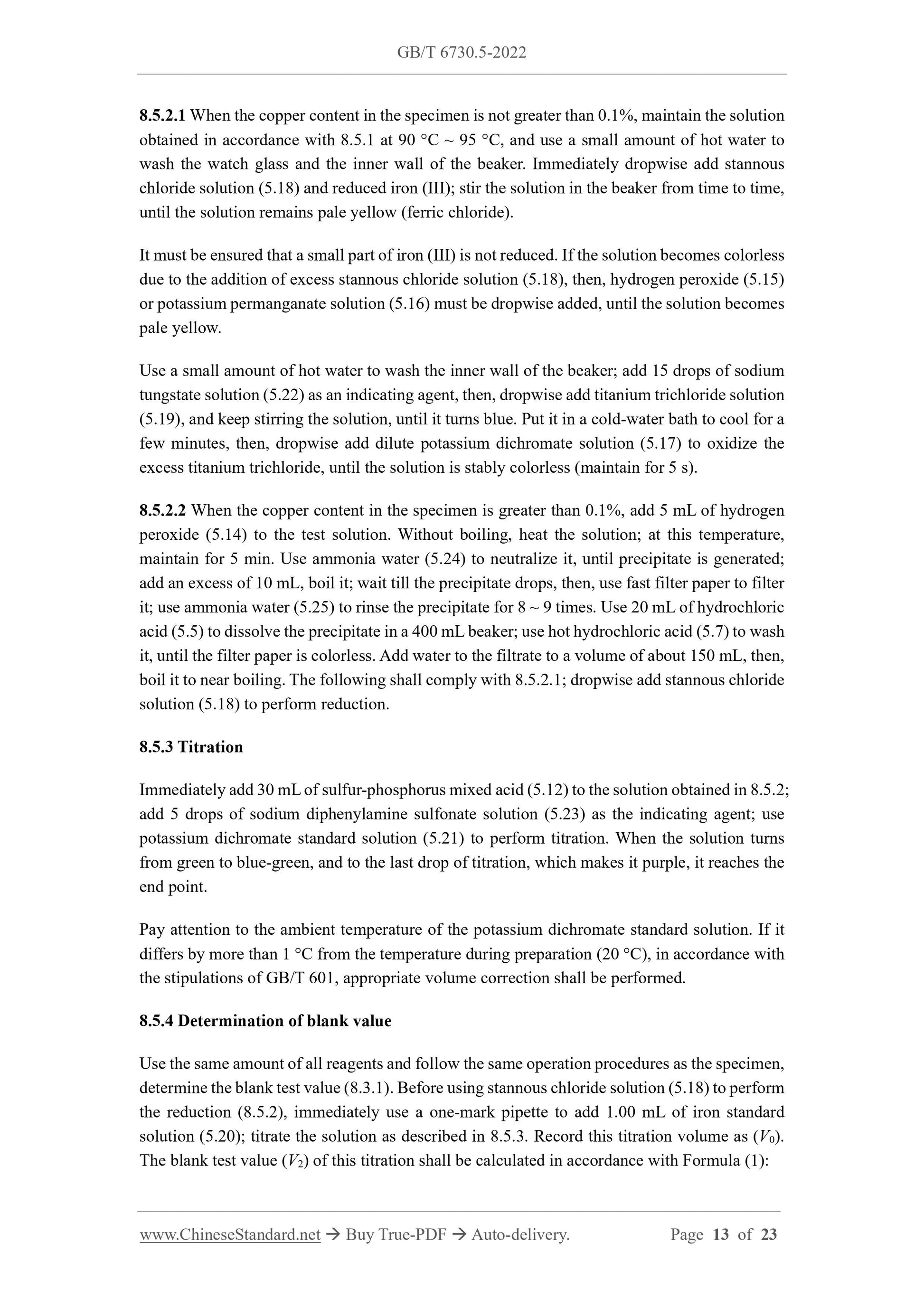1
/
of
8
PayPal, credit cards. Download editable-PDF and invoice in 1 second!
GB/T 6730.5-2022 English PDF (GBT6730.5-2022)
GB/T 6730.5-2022 English PDF (GBT6730.5-2022)
Regular price
$260.00 USD
Regular price
Sale price
$260.00 USD
Unit price
/
per
Shipping calculated at checkout.
Couldn't load pickup availability
Delivery: 3 seconds. Download true-PDF + Invoice.
Get QUOTATION in 1-minute: Click GB/T 6730.5-2022
Historical versions: GB/T 6730.5-2022
Preview True-PDF (Reload/Scroll if blank)
GB/T 6730.5-2022: Iron ores -- Determination of total iron content -- Titrimetric methods after titanium(III) chloride reduction
GB/T 6730.5-2022
NATIONAL STANDARD OF THE
PEOPLE’S REPUBLIC OF CHINA
ICS 73.060.10
CCS D 31
Replacing GB/T 6730.5-2007
Iron Ores - Determination of Total Iron Content -
Titrimetric Methods after Titanium (III) Chloride
Reduction
[ISO 2597-2:2019, Iron Ores - Determination of Total Iron Content - Part 2:
Titrimetric Methods after Titanium (III) Chloride Reduction, MOD]
ISSUED ON: APRIL 15, 2022
IMPLEMENTED ON: NOVEMBER 1, 2022
Issued by: State Administration for Market Regulation;
Standardization Administration of the People’s Republic of China.
Table of Contents
Foreword ... 3
Introduction ... 5
1 Scope ... 6
2 Normative References ... 6
3 Terms and Definitions ... 7
4 Principle ... 7
5 Reagents ... 7
6 Instruments ... 9
7 Specimen Collection and Preparation ... 10
8 Analytical Procedures ... 11
9 Result Calculation and Expression... 14
10 Test Report ... 16
Appendix A (informative) Constituent Documents of GB/T 6730 ... 18
Appendix B (normative) Acceptance Procedure of Specimen Analysis Results ... 23
Iron Ores - Determination of Total Iron Content -
Titrimetric Methods after Titanium (III) Chloride
Reduction
WARNING: personnel adopting this document shall have practical experience with
formal laboratory work. This document does not point out all possible security issues. It
is the user’s responsibility to take appropriate safety and health measures, and to ensure
the compliance with the conditions stipulated by relevant national regulations.
1 Scope
This document specifies the method for the determination of total iron content by potassium
dichromate titration method after reduction of iron with titanium trichloride.
This document is applicable to the determination of total iron content in natural iron ores, iron
ore concentrates and agglomerates, including sintered products, and the determination range
(mass fraction) is: 30.00% ~ 72.00%.
2 Normative References
The contents of the following documents constitute indispensable clauses of this document
through the normative references in this text. In terms of references with a specified date, only
versions with a specified date are applicable to this document. In terms of references without a
specified date, the latest version (including all the modifications) is applicable to this document.
GB/T 601 Chemical Reagent - Preparations of Reference Titration Solutions
GB/T 6682 Water for Analytical Laboratory Use - Specification and Test Methods (GB/T 6682-
2008, ISO 3696:1987, MOD)
GB/T 6730.1 Iron Ores - Preparation of Predried Test Samples for Chemical Analysis (GB/T
6730.1-2016, ISO 7764:2006, MOD)
GB/T 6730.3 Iron Ores - Determination of Hydroscopic Moisture in Analytical Samples -
Gravimetric, Karl Fischer and Mass-loss Methods (GB/T 6730.3-2017, ISO 2596:2006, MOD)
GB/T 8170 Rules of Rounding off for Numerical Values and Expression and Judgement of
Limiting Values
GB/T 10322.1 Iron Ores - Sampling and Sample Preparation Procedures (GB/T 10322.1-2014,
ISO 3082:2009, IDT)
GB/T 12805 Laboratory Glassware - Burettes (GB/T 12805-2011, ISO 385:2005, NEQ)
GB/T 12806 Laboratory Glassware - One-mark Volumetric Flasks (GB/T 12806-2011, ISO
1042:1998, NEQ)
GB/T 12808 Laboratory Glassware - One-mark Pipettes
3 Terms and Definitions
This document does not have terms or definitions that need to be defined.
4 Principle
4.1 Decomposition of Specimen
4.1.1 Acid decomposition
For specimen containing no more than 0.05% vanadium, use hydrochloric acid to dissolve the
specimen; after filtering and burning the residue, use hydrofluoric acid and sulfuric acid to treat
the specimen; use potassium pyrosulfate to melt it; leach the melt and combine it with the main
liquid; use potassium permanganate solution for oxidation.
4.1.2 Melting-filtration
For specimen containing over 0.05% vanadium, use alkali to melt it; use water to leach the
cooled melt and filter it; after using sodium hydroxide solution to rinse the precipitate, use
hydrochloric acid to dissolve the precipitate.
4.2 Titration
Most of the iron is reduced by stannous chloride, and the remaining iron is reduced by titanium
trichloride. Use dilute potassium dichromate solution to oxidize the excess reducing agent. Take
sodium diphenylamine sulfonate as the indicating agent and use potassium dichromate solution
to titrate the reduced iron.
5 Reagents
Unless it is otherwise specified in the analysis, only approved analytically pure reagents, and
distilled water that complies with the stipulations of GB/T 6682, or water of equivalent purity
can be used.
5.1 Potassium pyrosulfate, fine powder.
5.2 Sodium carbonate, anhydrous or pre-burned at 500 C.
5.3 Sodium peroxide (Na2O2), dry powder. Sodium peroxide shall be stored as dry as possible
dissolved. After cooling, slowly add 5 mL of hydrogen peroxide solution (5.15); heat it to
boiling, and boil until excess hydrogen peroxide decomposes, then, remove chlorine. After
cooling to room temperature, transfer it into a 1,000 mL volumetric flask; use water to dilute to
the scale; mix it up.
1.00 mL of this solution is equivalent to 1.00 mL of potassium dichromate standard solution
(5.21).
5.21 Potassium dichromate standard solution, 0.01667 mol/L.
Weigh-take 4.904 g of potassium dichromate (standard reagent) that has been pre-dried at 140
C ~ 150 C for 2h and cooled to room temperature in a desiccator into a 300 mL beaker. Add
100 mL of water to dissolve it, transfer it to a 1,000 mL volumetric flask; cool it to 20 C, then,
use water to dilute to the scale; mix it up.
The used volumetric flask shall comply with the requirements of Level-A volumetric flasks in
GB/T 12806. If necessary, the volumetric flask shall be calibrated in advance. For each
application, the actual temperature shall be measured, and the volume of the used solution shall
be corrected. Mark the temperature, at which, the solution was diluted (20 C) on the storage
bottle.
The water used to prepare the standard solution shall be subjected to the temperature and
humidity balance treatment at room temperature in advance. Immerse the calibrated mercury
thermometer with a division value of 0.1 C in the pipetted standard solution; after over 60 s,
read the temperature, accurate to 0.1 C.
5.22 Sodium tungstate solution, 250 g/L.
Weigh-take 25 g of sodium tungstate and dissolve it in an appropriate amount of water (if it is
turbid, filter it). Add 5 mL of phosphoric acid (5.11) and use water to dilute to 100 mL.
5.23 Sodium diphenylamine sulfonate indicating agent, 2 g/L.
Dissolve 0.2 g of sodium diphenylamine sulfonate (C6H5NHC6H4SO3Na) in a small amount of
water, then, dilute it to 100 mL. Store this solution in a brown glass bottle.
5.24 Ammonia water, is about 0.90 g/mL.
5.25 Ammonia water, 5 + 95.
6 Instruments
Unless it is otherwise specified, the used one-mark volumetric flasks and one-mark pipettes
shall comply with the stipulations of GB/T 12806 and GB/T 12808.
6.1 Corundum crucible, with a capacity of 25 mL ~ 30 mL.
6.2 Burette, Grade-A, comply with the stipulations of GB/T 12805.
6.3 Platinum crucible, with a capacity of 25 mL ~ 30 mL, with a lid.
6.4 Weighing spoon, made of non-magnetic material or demagnetized stainless steel.
6.5 High-temperature furnace, with a temperature preferably controlled within the range of 500
C ~ 800 C.
6.6 Balance, with a division value of 0.0001 g.
7 Specimen Collection and Prep...
Get QUOTATION in 1-minute: Click GB/T 6730.5-2022
Historical versions: GB/T 6730.5-2022
Preview True-PDF (Reload/Scroll if blank)
GB/T 6730.5-2022: Iron ores -- Determination of total iron content -- Titrimetric methods after titanium(III) chloride reduction
GB/T 6730.5-2022
NATIONAL STANDARD OF THE
PEOPLE’S REPUBLIC OF CHINA
ICS 73.060.10
CCS D 31
Replacing GB/T 6730.5-2007
Iron Ores - Determination of Total Iron Content -
Titrimetric Methods after Titanium (III) Chloride
Reduction
[ISO 2597-2:2019, Iron Ores - Determination of Total Iron Content - Part 2:
Titrimetric Methods after Titanium (III) Chloride Reduction, MOD]
ISSUED ON: APRIL 15, 2022
IMPLEMENTED ON: NOVEMBER 1, 2022
Issued by: State Administration for Market Regulation;
Standardization Administration of the People’s Republic of China.
Table of Contents
Foreword ... 3
Introduction ... 5
1 Scope ... 6
2 Normative References ... 6
3 Terms and Definitions ... 7
4 Principle ... 7
5 Reagents ... 7
6 Instruments ... 9
7 Specimen Collection and Preparation ... 10
8 Analytical Procedures ... 11
9 Result Calculation and Expression... 14
10 Test Report ... 16
Appendix A (informative) Constituent Documents of GB/T 6730 ... 18
Appendix B (normative) Acceptance Procedure of Specimen Analysis Results ... 23
Iron Ores - Determination of Total Iron Content -
Titrimetric Methods after Titanium (III) Chloride
Reduction
WARNING: personnel adopting this document shall have practical experience with
formal laboratory work. This document does not point out all possible security issues. It
is the user’s responsibility to take appropriate safety and health measures, and to ensure
the compliance with the conditions stipulated by relevant national regulations.
1 Scope
This document specifies the method for the determination of total iron content by potassium
dichromate titration method after reduction of iron with titanium trichloride.
This document is applicable to the determination of total iron content in natural iron ores, iron
ore concentrates and agglomerates, including sintered products, and the determination range
(mass fraction) is: 30.00% ~ 72.00%.
2 Normative References
The contents of the following documents constitute indispensable clauses of this document
through the normative references in this text. In terms of references with a specified date, only
versions with a specified date are applicable to this document. In terms of references without a
specified date, the latest version (including all the modifications) is applicable to this document.
GB/T 601 Chemical Reagent - Preparations of Reference Titration Solutions
GB/T 6682 Water for Analytical Laboratory Use - Specification and Test Methods (GB/T 6682-
2008, ISO 3696:1987, MOD)
GB/T 6730.1 Iron Ores - Preparation of Predried Test Samples for Chemical Analysis (GB/T
6730.1-2016, ISO 7764:2006, MOD)
GB/T 6730.3 Iron Ores - Determination of Hydroscopic Moisture in Analytical Samples -
Gravimetric, Karl Fischer and Mass-loss Methods (GB/T 6730.3-2017, ISO 2596:2006, MOD)
GB/T 8170 Rules of Rounding off for Numerical Values and Expression and Judgement of
Limiting Values
GB/T 10322.1 Iron Ores - Sampling and Sample Preparation Procedures (GB/T 10322.1-2014,
ISO 3082:2009, IDT)
GB/T 12805 Laboratory Glassware - Burettes (GB/T 12805-2011, ISO 385:2005, NEQ)
GB/T 12806 Laboratory Glassware - One-mark Volumetric Flasks (GB/T 12806-2011, ISO
1042:1998, NEQ)
GB/T 12808 Laboratory Glassware - One-mark Pipettes
3 Terms and Definitions
This document does not have terms or definitions that need to be defined.
4 Principle
4.1 Decomposition of Specimen
4.1.1 Acid decomposition
For specimen containing no more than 0.05% vanadium, use hydrochloric acid to dissolve the
specimen; after filtering and burning the residue, use hydrofluoric acid and sulfuric acid to treat
the specimen; use potassium pyrosulfate to melt it; leach the melt and combine it with the main
liquid; use potassium permanganate solution for oxidation.
4.1.2 Melting-filtration
For specimen containing over 0.05% vanadium, use alkali to melt it; use water to leach the
cooled melt and filter it; after using sodium hydroxide solution to rinse the precipitate, use
hydrochloric acid to dissolve the precipitate.
4.2 Titration
Most of the iron is reduced by stannous chloride, and the remaining iron is reduced by titanium
trichloride. Use dilute potassium dichromate solution to oxidize the excess reducing agent. Take
sodium diphenylamine sulfonate as the indicating agent and use potassium dichromate solution
to titrate the reduced iron.
5 Reagents
Unless it is otherwise specified in the analysis, only approved analytically pure reagents, and
distilled water that complies with the stipulations of GB/T 6682, or water of equivalent purity
can be used.
5.1 Potassium pyrosulfate, fine powder.
5.2 Sodium carbonate, anhydrous or pre-burned at 500 C.
5.3 Sodium peroxide (Na2O2), dry powder. Sodium peroxide shall be stored as dry as possible
dissolved. After cooling, slowly add 5 mL of hydrogen peroxide solution (5.15); heat it to
boiling, and boil until excess hydrogen peroxide decomposes, then, remove chlorine. After
cooling to room temperature, transfer it into a 1,000 mL volumetric flask; use water to dilute to
the scale; mix it up.
1.00 mL of this solution is equivalent to 1.00 mL of potassium dichromate standard solution
(5.21).
5.21 Potassium dichromate standard solution, 0.01667 mol/L.
Weigh-take 4.904 g of potassium dichromate (standard reagent) that has been pre-dried at 140
C ~ 150 C for 2h and cooled to room temperature in a desiccator into a 300 mL beaker. Add
100 mL of water to dissolve it, transfer it to a 1,000 mL volumetric flask; cool it to 20 C, then,
use water to dilute to the scale; mix it up.
The used volumetric flask shall comply with the requirements of Level-A volumetric flasks in
GB/T 12806. If necessary, the volumetric flask shall be calibrated in advance. For each
application, the actual temperature shall be measured, and the volume of the used solution shall
be corrected. Mark the temperature, at which, the solution was diluted (20 C) on the storage
bottle.
The water used to prepare the standard solution shall be subjected to the temperature and
humidity balance treatment at room temperature in advance. Immerse the calibrated mercury
thermometer with a division value of 0.1 C in the pipetted standard solution; after over 60 s,
read the temperature, accurate to 0.1 C.
5.22 Sodium tungstate solution, 250 g/L.
Weigh-take 25 g of sodium tungstate and dissolve it in an appropriate amount of water (if it is
turbid, filter it). Add 5 mL of phosphoric acid (5.11) and use water to dilute to 100 mL.
5.23 Sodium diphenylamine sulfonate indicating agent, 2 g/L.
Dissolve 0.2 g of sodium diphenylamine sulfonate (C6H5NHC6H4SO3Na) in a small amount of
water, then, dilute it to 100 mL. Store this solution in a brown glass bottle.
5.24 Ammonia water, is about 0.90 g/mL.
5.25 Ammonia water, 5 + 95.
6 Instruments
Unless it is otherwise specified, the used one-mark volumetric flasks and one-mark pipettes
shall comply with the stipulations of GB/T 12806 and GB/T 12808.
6.1 Corundum crucible, with a capacity of 25 mL ~ 30 mL.
6.2 Burette, Grade-A, comply with the stipulations of GB/T 12805.
6.3 Platinum crucible, with a capacity of 25 mL ~ 30 mL, with a lid.
6.4 Weighing spoon, made of non-magnetic material or demagnetized stainless steel.
6.5 High-temperature furnace, with a temperature preferably controlled within the range of 500
C ~ 800 C.
6.6 Balance, with a division value of 0.0001 g.
7 Specimen Collection and Prep...
Share
